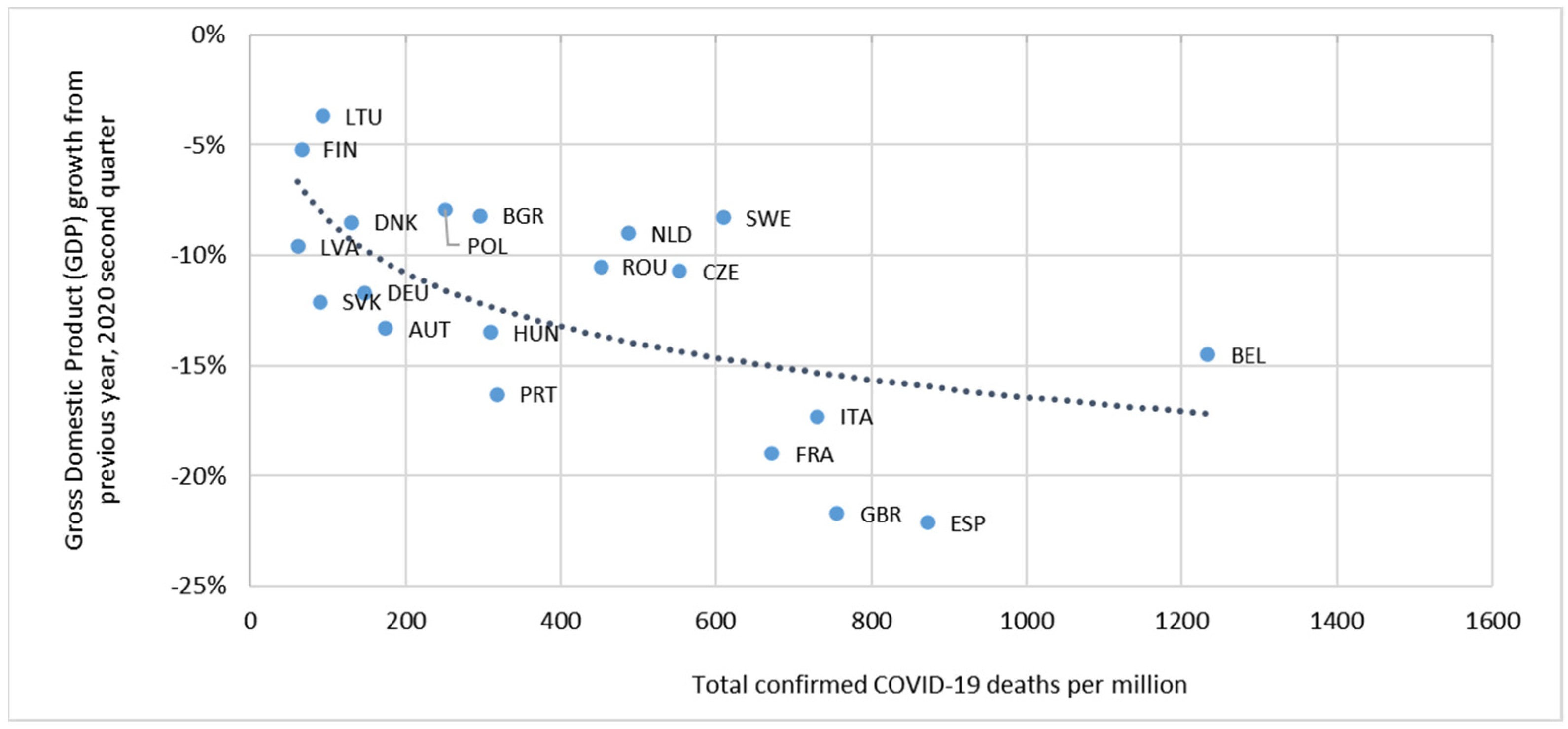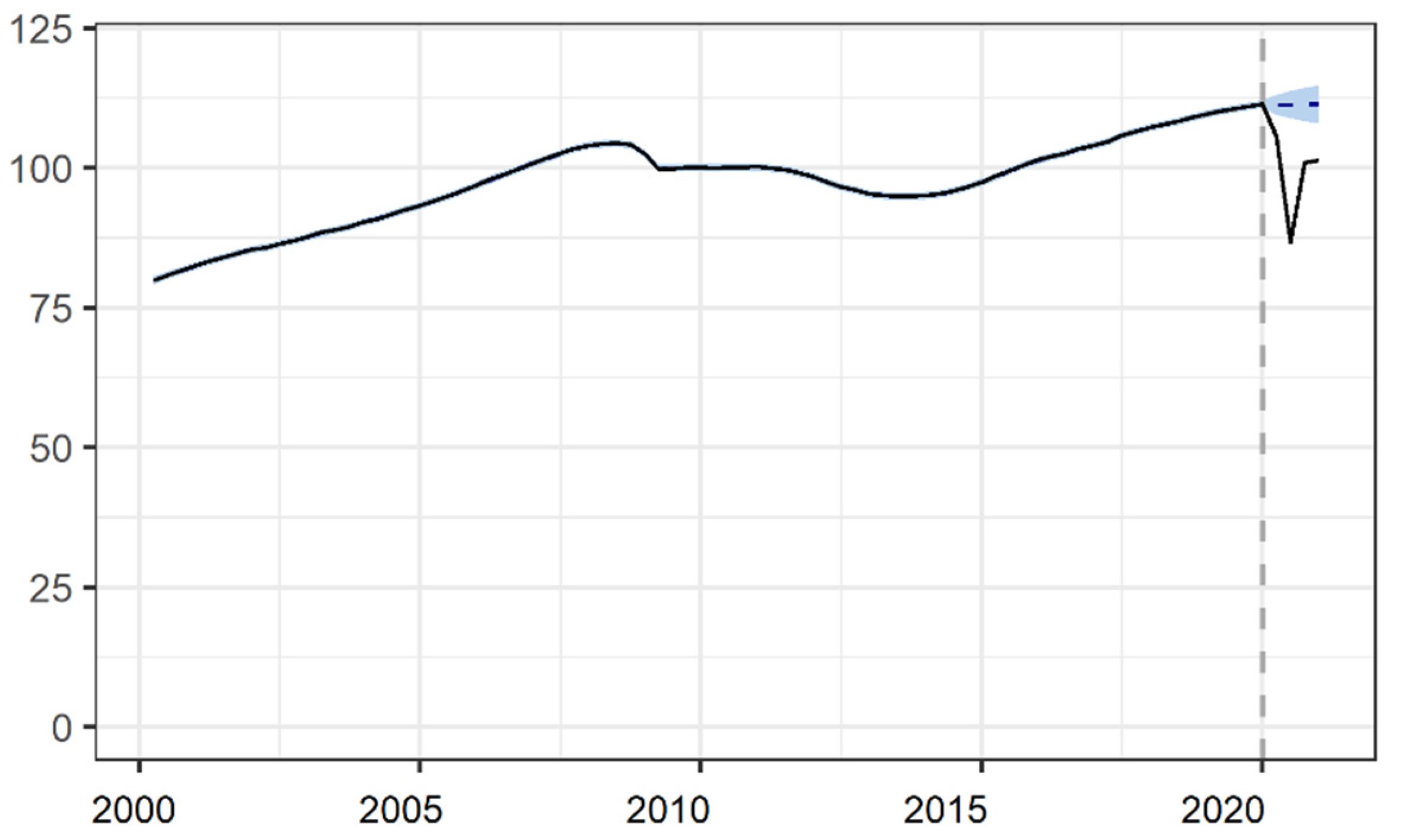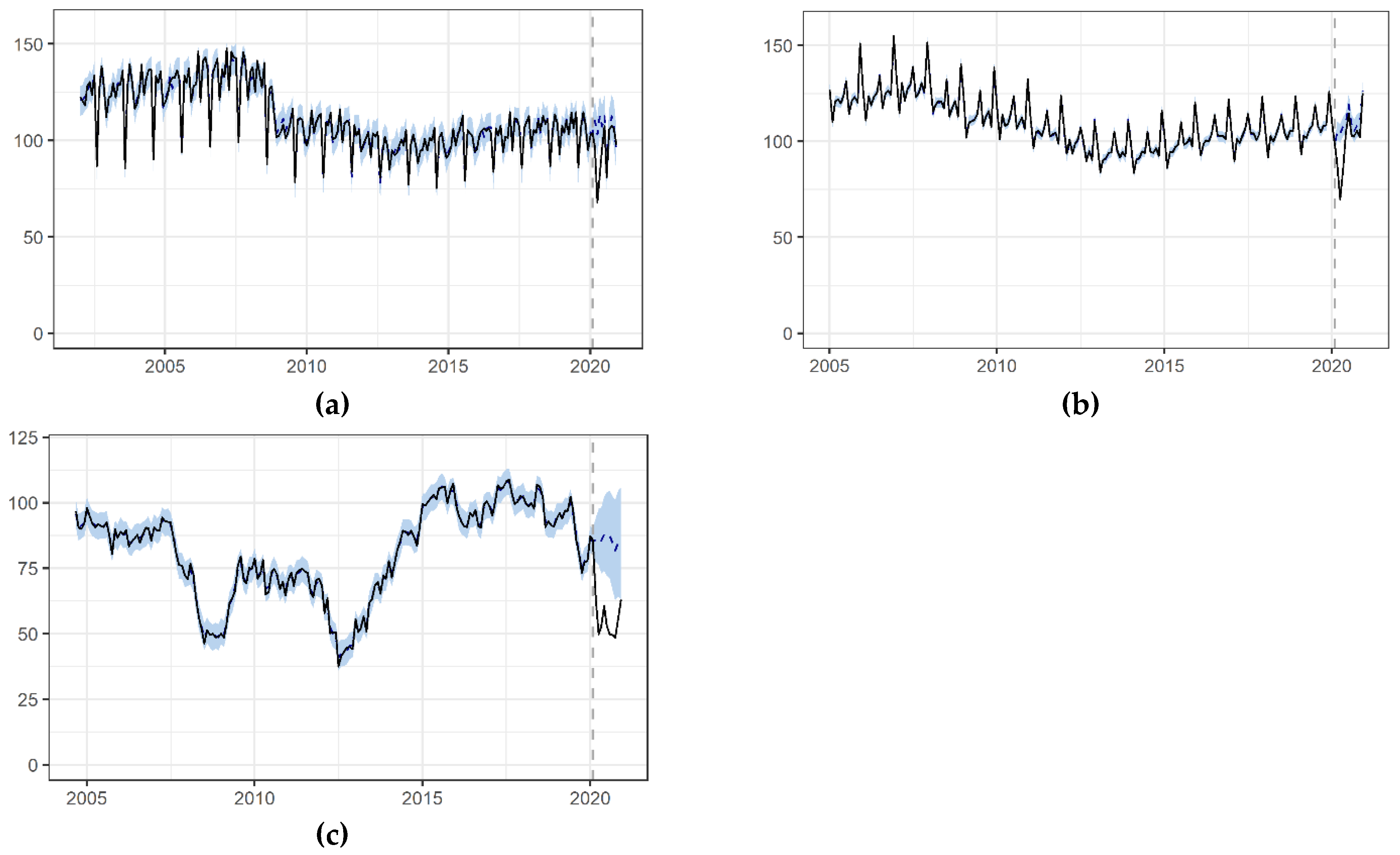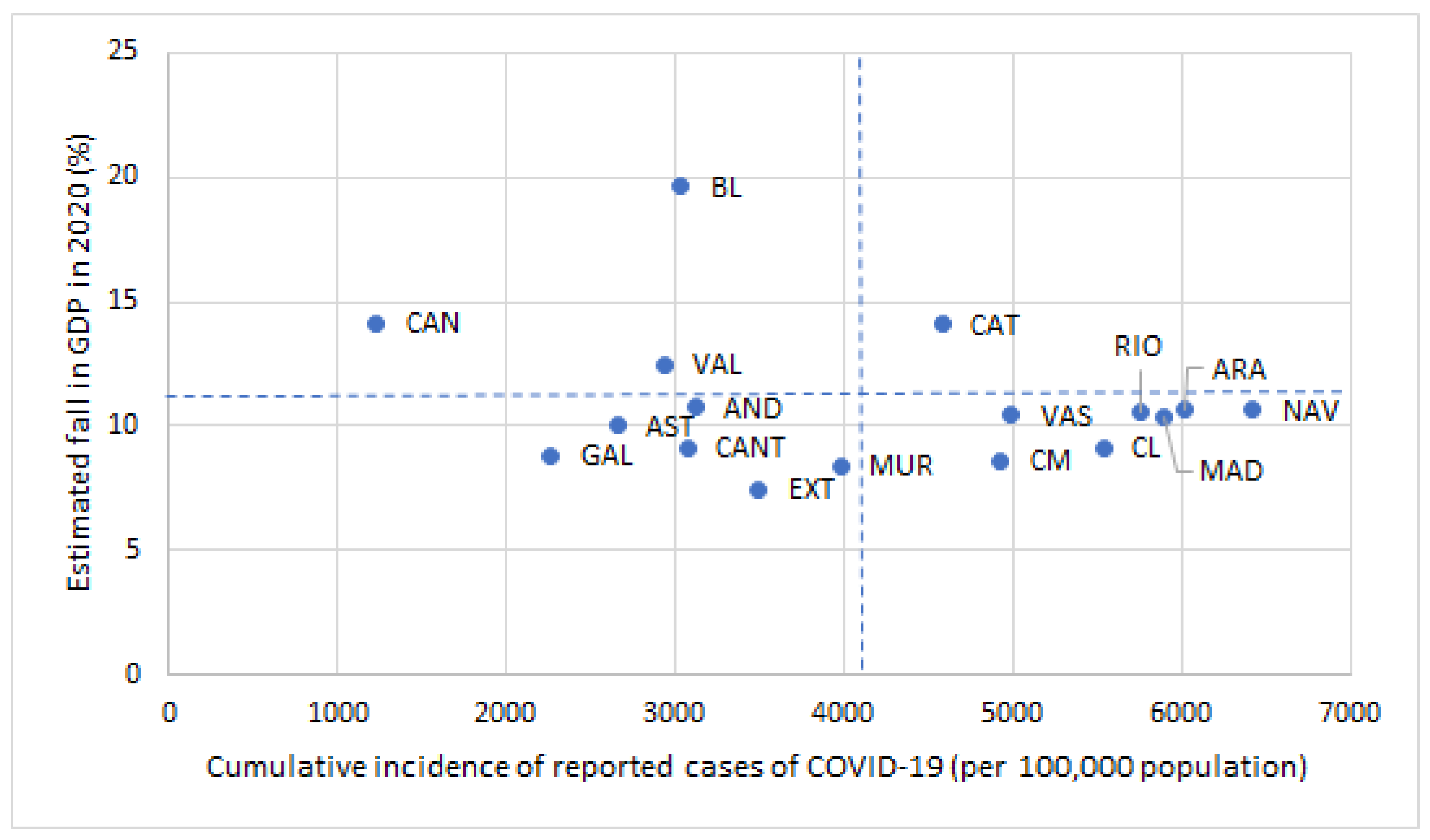The Economic Impact of the SARS-COV-2 (COVID-19) Pandemic in Spain
Abstract
1. Introduction
2. Materials and Methods
2.1. Data
- I.
- General macroeconomic aggregate.
- Gross domestic product volume index (GDP). Quarterly data by ACs, seasonally and calendar adjusted. Time series from the first quarter of 2000 to the fourth quarter of 2020. GDP is the most frequently used measure for the overall size of an economy. GDP-index in volume represents the variations in the volume of production of an economy.
- II.
- Production, supply, and demand.
- Industrial production index (IPI). Monthly data by ACs (base 2015). Time series from January 2002 to December 2020. The (IPI) measures the monthly evolution of the productive activity of the industrial branches, that is, of the extractive, manufacturing, production, and distribution activities of electrical energy, water, and gas.
- Business turnover index (BTI). Monthly data by ACs (base 2015). Time series from January 2005 to December 2020. The BTI is an indicator that measures the short-term evolution of turnover, as a whole, for non-financial economic sectors.
- Consumer confidence index (CCI). Monthly data at the national level. Time series from September 2004 to December 2020. The CCI offers an insight into consumers’ spending intentions, asking them about their current perception of the country’s economy and its prospects, their family economy, and employment.
- III.
- Labor Market.
- Unemployment rate, percentage of unemployed workers in the total labor force. Quarterly data by ACs and economic sector (agriculture, industry, and services). Data from the Economically Active Population survey (EPA in Spanish). Time series from the first quarter of 2008 to the fourth quarter of 2020.
2.2. Statistical Analysis
3. Results
3.1. Gross Domestic Product
3.2. Production, Supply, and Demand Short-Term Indicators
3.3. Labor Market: Unemployment
3.4. Economics and Health: Is There an Association between Economic Downturn and COVID-19 Incidence?
4. Discussion
5. Conclusions
Author Contributions
Funding
Institutional Review Board Statement
Informed Consent Statement
Data Availability Statement
Conflicts of Interest
References
- World Health Organization. Available online: https://www.who.int/csr/don/05-january-2020-pneumonia-of-unkown-cause-china/es/ (accessed on 16 January 2021).
- World Health Organization. Available online: https://www.who.int/docs/default-source/coronaviruse/situation-reports/20200130-sitrep-10-ncov.pdf?sfvrsn=d0b2e480_2 (accessed on 16 January 2021).
- International Monetary Fund. World Economic Outlook. Available online: https://www.imf.org/en/Publications/WEO/Issues/2020/01/20/weo-update-january2020 (accessed on 16 January 2021).
- Coronavirus Pandemic (COVID-19). Available online: https://ourworldindata.org/coronavirus (accessed on 16 January 2021).
- Instituto de Salud Carlos III. Vigilancia de los Excesos de Mortalidad Por Todas las Causas. Available online: https://www.isciii.es/QueHacemos/Servicios/VigilanciaSaludPublicaRENAVE/EnfermedadesTransmisibles/MoMo/Documents/informesMoMo2021/MoMo_Situacion%20a%205%20de%20enero_CNE.pdf (accessed on 12 April 2021).
- García-Basteiro, A.; Alvarez-Dardet, C.; Arenas, A.; Bengoa, R.; Borrell, C.; Del Val, M.; Franco, M.; Gea-Sánchez, M.; Gestal Otero, J.J.; López Valcárcel, B.G.; et al. The need for an independent evaluation of the COVID-19 response in Spain. Lancet 2020, 396, 529–530. [Google Scholar] [CrossRef]
- López-Valcárcel, B.G.; Meneu, R. El gasto que está triste y azul: Debe preocupar más la salud que el gasto sanitario. Gac. Sanit. 2012, 26, 176–177. [Google Scholar] [CrossRef] [PubMed]
- Sisó-Almirall, A. El Desafío de la COVID-19 Para la Atención Primaria y Comunitaria. Available online: http://www.aes.es/blog/2020/05/27/el-desafio-de-la-covid-19-para-la-atencion-primaria-y-comunitaria/ (accessed on 16 January 2021).
- OECD. Health at a Glance: Europe 2018. Available online: https://www.oecd-ilibrary.org/social-issues-migration-health/health-at-a-glance-europe-2018/health-expenditure-per-capita_health_glance_eur-2018-29-en;jsessionid=85quQOGAsLpny1ZgYaxNpWbC.ip-10-240-5-7 (accessed on 16 January 2021).
- The Health System Response Monitor (HSRM). Health System Responses to COVID-19. Eurohealth 2020 (26.2). Available online: https://eurohealthobservatory.who.int/publications/i/health-system-responses-to-covid-19 (accessed on 16 January 2021).
- Altig, D.; Baker, S.; Barrero, J.M.; Bloom, N.; Bunn, P.; Chen, S.; Davis, S.J.; Leather, J.; Meyer, B.; Mihaylov, E.; et al. Economic uncertainty before and during the COVID-19 pandemic. J. Public Econ. 2020, 191, 1–13. [Google Scholar] [CrossRef] [PubMed]
- Carlsson-Szlezak, P.; Reeves, M.; Swartz, P. Understanding the Economic Shock of Coronavirus. Harv. Bus. Rev. 2020. Available online: https://hbr.org/2020/03/understanding-the-economic-shock-of-coronavirus (accessed on 16 January 2021).
- Ayala, L. The Potential Consequences of COVID-19 on Poverty; Institut d’Economia de Barcelona (IEB) Report; Universitat de Barcelona: Barcelona, Spain, 2020; pp. 7–9. [Google Scholar]
- Alvargonzález, P.; Pidkuyko, M.; Villanueva, E. The financial position of the workers most affected by the oandemic: An analysis drawing on the Spanish Survey of Household Finances. Econ. Bull. Banco España Artic. 2020, 3. Available online: https://ssrn.com/abstract=3661500 (accessed on 16 January 2021).
- Brodeur, A.; Gray, D.M.; Anik, I.; Suraiya, B. A Literature Review of the Economics of Covid-19. IZA Discussion Paper 2020, 13411. Available online: https://ssrn.com/abstract=3636640 (accessed on 16 January 2021).
- Janssen, J.; Bar-Yam, Y. Lowest-Cost Virus Suppression. arXiv 2021, arXiv:2102.04758. Available online: https://arxiv.org/abs/2102.04758 (accessed on 12 April 2021).
- López-Valcárcel, B.G.; Vallejo-Torres, L. The costs of COVID-19 and the cost-effectiveness of testing. Appl. Econ. Anal. 2021, 11, 1–13. [Google Scholar]
- Eurostat Statistic Explained Online Publication. Building the System of National Accounts—Basic Concepts. Available online: https://ec.europa.eu/eurostat/statistics-explained/index.php?title=Building_the_System_of_National_Accounts_-_basic_concepts (accessed on 16 January 2021).
- Harvey, A.C. Structural Time Series and the Kalman Filter; Cambridge University Press: Cambridge, UK, 1989. [Google Scholar]
- Scott, S.L.; Varian, H.R. Predicting the present with Bayesian Structural Time Series. Int. J. Math. Model. Numer. Optim. 2014, 5, 4–23. [Google Scholar] [CrossRef]
- McQuire, C.; Tilling, K.; Hickman, M.; de Vocht, F. Forecasting the 2021 local burden of population alcohol related harms using Bayesian structural time-series. Addiction 2019, 114, 994–1003. [Google Scholar] [CrossRef] [PubMed]
- de Vocht, F.; Tilling, K.; Pliakas, T.; Angus, C.; Egan, M.; Brennan, A.; Cambell, R.; Hickman, M. The intervention effect of local alcohol licensing policies on hospital admission and crime: A natural experiment using a novel Bayesian synthetic time-series method. J. Epidemiol. Community Health 2017, 71, 912–918. [Google Scholar] [CrossRef] [PubMed]
- Pinilla, J.; Negrín, M.; López-Valcárcel, B.G.; Vázquez-Polo, F. Using a Bayesian Structural Time–Series Model to Infer the Causal Impact on Cigarette Sales of Partial and Total Bans on Public Smoking. Jahrbücher für Nationalökonomie und Statistik 2018, 238, 423–439. [Google Scholar] [CrossRef]
- Feroze, N. Forecasting the patterns of COVID-19 and causal impacts of lockdown in top five affected countries using Bayesian Structural Time Series Models. Chaos Solitons Fractals 2020, 140, 110196. [Google Scholar] [CrossRef] [PubMed]
- Brodersen, K.H.; Gallusser, F.; Koehler, J.; Remy, N.; Scott, S.L. Inferring causal impact using Bayesian structural time-series models. Ann. Appl. Statatistics 2015, 9, 247–274. [Google Scholar] [CrossRef]
- CausalImpact, B.K. An R Package for Causal Inference Using Bayesian Structural Time-Series Models. 2015. Available online: https://google.github.io/CausalImpact/CausalImpact.html (accessed on 26 February 2021).
- BBVA Research, Publicaciones de Análisis Regional España. Available online: https://www.bbvaresearch.com (accessed on 30 January 2021).
- Boscá, J.E.; Doménech, R.; Feri, J. El Impacto Macroeconómico del Coronavirus. Fedea Apuntes 2020, 2. Available online: https://documentos.fedea.net/pubs/ap/2020/ap2020-02.pdf (accessed on 30 January 2021).
- Fernández, A. The economic performance of Spanish provinces during 2020 and its determinants. Banco de España. Econ. Bull. Anal. Artic. 2021, 1, 03/21. [Google Scholar]
- Conesa, J.C.; Fernández, G.; Kehoe, T.J. La crisis económica de COVID-19: Vías de Salvación. Aspectos económicos de la crisis del Covid-19. Coordinadores Felgueroso, F., de la Fuente, A.; Jansen, M. Estudios sobre la Economía Española. FEDEA Boletín de Seguimiento 2020, 6, 7. [Google Scholar]
- OECD. Tourism Trends and Policies 2020. OECD Publishing, Paris. Available online: https://www.oecd.org/cfe/tourism/OECD-Tourism-Trends-Policies%202020-Highlights-ENG.pdf (accessed on 16 January 2021).
- Instituto Nacional de Estadística (INE), Movimientos turísticos en fronteras. Frontur. Available online: https://www.ine.es/dyngs/INEbase/es/operacion.htm?c=Estadistica_C&cid=1254736176996&menu=ultiDatos&idp=1254735576863 (accessed on 16 January 2021).
- Instituto Nacional de Estadística (INE), Índice de Producción Industrial Base 2015. Available online: https://www.ine.es/dyngs/INEbase/es/operacion.htm?c=Estadistica_C&cid=1254736145519&menu=resultados&idp=1254735576715#!tabs-1254736194962 (accessed on 16 January 2021).
- Asociación Española de Fabricantes de Automóviles y Camiones (Anfac). Informe de Producción y Exportación de Vehículos. Available online: https://anfac.com/actualidad/la-produccion-de-espana-se-reduce-un-196-con-227-millones-de-vehiculos-fabricados-en-2020/ (accessed on 16 January 2021).
- Ministerio de Trabajo y Economía Social. Estad’sticas de Empresas Inscritas en la Seguridad Social. Available online: https://www.mites.gob.es/estadisticas/emp/welcome.htm (accessed on 16 January 2021).
- Instituto Nacional de Estadística (INE), Contabilidad Nacional Trimestral (CNTR). Available online: https://www.ine.es/dyngs/INEbase/es/operacion.htm?c=Estadistica_C&cid=1254736164439&menu=resultados&idp=1254735576581 (accessed on 16 January 2021).
- Eurobarometer European Commission. Available online: https://ec.europa.eu/commfrontoffice/publicopinion/index.cfm (accessed on 16 January 2021).





| Autonomous Community | GDP Volume Index Pandemic Measuring Period (1st Quarter 2020 to 4th Quarter 2020) | |
|---|---|---|
| Andalusia | −10.73% | [−12.88; −8.55] |
| Aragon | −10.71% | [−13.02; −8.36] |
| Asturias | −10.00% | [−12.22; −7.75] |
| Balearic Islands | −19.61% | [−21.65; −17.53] |
| Canary Islands | −14.09% | [−16.13; −12.03] |
| Cantabria | −9.09% | [−11.09; −7.03] |
| Castile-La Mancha | −8.56% | [−11.19; −5.93] |
| Castile and León | −9.12% | [−10.95; −7.28] |
| Catalonia | −14.07% | [−16.33; −11.82] |
| Valencian C. | −12.49% | [−14.93; −10.03] |
| Extremadura | −7.45% | [−9.46; −5.42] |
| Galicia | −8.81% | [−10.96; −6.62] |
| La Rioja | −10.61% | [−13.05; −8.16] |
| Madrid | −10.39% | [−12.51; −8.23] |
| Murcia | −8.42% | [−10.92; −5.94] |
| Navarre | −10.64% | [−12.94; −8.34] |
| Basque Country | −10.43% | [−12.45; −8.38] |
| Total Spain | −11.41% | [−13.46; −9.29] |
| Autonomous Community | Industrial Production Index Pandemic Measuring Period (March 2020 to December 2020) | Business Turnover Index Pandemic Measuring Period (March 2020 to December 2020) | ||
|---|---|---|---|---|
| Andalusia | −9.63% | [−17.24; −2.02] | −11.39% | [−15.18; −7.71] |
| Aragon | −10.11% | [−17.52; −2.92] | −8.19% | [−12.01; −4.37] |
| Asturias | −15.30% | [−21.52; −9.04] | −5.34% | [−8.86; −1.85] |
| Balearic Islands | −22.36% | [−33.14; −11.71] | −16.81% | [−20.98; −12.73] |
| Canary Islands | −13.17% | [−18.35; −7.96] | −18.43% | [−22.23; −14.66] |
| Cantabria | −8.09% | [−14.23; −2.13] | −6.81% | [−10.4; −3.28] |
| Castile-La Mancha | −8.77% | [−15.14; −2.52] | −5.16% | [−9.14; −1.23] |
| Castile and León | −9.63% | [−18.00; −1.59] | −8.07% | [−11.42; −4.74] |
| Catalonia | −10.32% | [−16.24; −4.49] | −11.77% | [−15.41; −8.18] |
| Valencian C. | −6.76% | [−12.76; −0.82] | −7.86% | [−11.95; −3.8] |
| Extremadura | −0.35% | [−9.36; 8.81] | −8.08% | [−10.84; −5.38] |
| Galicia | −12.48% | [−19.52; −5.75] | −3.23% | [−6.74; 0.24] |
| La Rioja | −13.47% | [−21.05; −6.06] | −6.13% | [−10.17; −2.18] |
| Madrid | −7.35% | [−13.77; −1.04] | −6.49% | [−10.45; −2.58] |
| Murcia | −0.31% | [−8.28; 7.53] | −9.61% | [−14.03; −5.17] |
| Navarre | −14.05% | [−21.31; −7.14] | −6.92% | [−10.19; −3.67] |
| Basque Country | −15.65% | [−23.01; −8.51] | −5.45% | [−8.86; −2.12] |
| Total Spain | −9.92% | [−15.68; −4.26] | −9.37% | [−12.71; −6.07] |
| Consumer Confidence Index Pandemic measuring period (September 2004 to December 2020) | Total Spain −36.26% [−51.82%; −20.84%] | |||
| Autonomous Community | Total Unemployment Rates Pandemic Measuring Period (1st Quarter 2020 to 4th Quarter 2020) | Services Sector Unemployment Rates Pandemic Measuring Period (1st Quarter 2020 to 4th Quarter 2020) | ||
|---|---|---|---|---|
| Andalusia | 6.7% | [2.43; 11.05] | 23.11% | [8.32; 37.89] |
| Aragon | 15.4% | [5.54; 25.25] | 34.03% | [12.25; 55.81] |
| Asturias | 4.4% | [1.57; 7.17] | 27.52% | [9.91; 45.14] |
| Balearic Islands | 58.1% | [20.91; 95.26] | 74.82% | [26.93; 122.7] |
| Canary Islands | 16.8% | [6.06; 27.62] | 39.63% | [14.27; 64.99] |
| Cantabria | 10.3% | [3.7; 16.84] | 31.73% | [11.42; 52.04] |
| Castile-La Mancha | 5.8% | [2.09; 9.5] | 1.60% | [−0.58; 2.62] |
| Castile and León | 6.0% | [2.17; 9.88] | 12.72% | [4.58; 20.87] |
| Catalonia | 20.8% | [7.49; 34.12] | 44.23% | [15.92; 72.53] |
| Valencian C. | 11.8% | [4.23; 19.27] | 19.34% | [6.96; 31.73] |
| Extremadura | 4.9% | [1.76; 8.03] | 7.81% | [2.81; 12.8] |
| Galicia | 0.1% | [0.04; 0.18] | 7.66% | [2.76; 12.56] |
| La Rioja | 8.5% | [3.06; 13.95] | 37.38% | [13.46; 61.31] |
| Madrid | 24.2% | [8.73; 39.75] | 41.69% | [15.01; 68.38] |
| Murcia | 3.1% | [1.13; 5.15] | 11.26% | [4.05; 18.46] |
| Navarre | 10.0% | [3.59; 16.34] | 48.25% | [17.37; 79.12] |
| Basque Country | 4.8% | [1.72; 7.86] | 17.54% | [6.32; 28.77] |
| Total Spain | 11.9% | [4.27; 19.45] | 27.68% | [9.96; 45.4] |
Publisher’s Note: MDPI stays neutral with regard to jurisdictional claims in published maps and institutional affiliations. |
© 2021 by the authors. Licensee MDPI, Basel, Switzerland. This article is an open access article distributed under the terms and conditions of the Creative Commons Attribution (CC BY) license (https://creativecommons.org/licenses/by/4.0/).
Share and Cite
Pinilla, J.; Barber, P.; Vallejo-Torres, L.; Rodríguez-Mireles, S.; López-Valcárcel, B.G.; Serra-Majem, L. The Economic Impact of the SARS-COV-2 (COVID-19) Pandemic in Spain. Int. J. Environ. Res. Public Health 2021, 18, 4708. https://doi.org/10.3390/ijerph18094708
Pinilla J, Barber P, Vallejo-Torres L, Rodríguez-Mireles S, López-Valcárcel BG, Serra-Majem L. The Economic Impact of the SARS-COV-2 (COVID-19) Pandemic in Spain. International Journal of Environmental Research and Public Health. 2021; 18(9):4708. https://doi.org/10.3390/ijerph18094708
Chicago/Turabian StylePinilla, Jaime, Patricia Barber, Laura Vallejo-Torres, Silvia Rodríguez-Mireles, Beatriz G. López-Valcárcel, and Luis Serra-Majem. 2021. "The Economic Impact of the SARS-COV-2 (COVID-19) Pandemic in Spain" International Journal of Environmental Research and Public Health 18, no. 9: 4708. https://doi.org/10.3390/ijerph18094708
APA StylePinilla, J., Barber, P., Vallejo-Torres, L., Rodríguez-Mireles, S., López-Valcárcel, B. G., & Serra-Majem, L. (2021). The Economic Impact of the SARS-COV-2 (COVID-19) Pandemic in Spain. International Journal of Environmental Research and Public Health, 18(9), 4708. https://doi.org/10.3390/ijerph18094708








